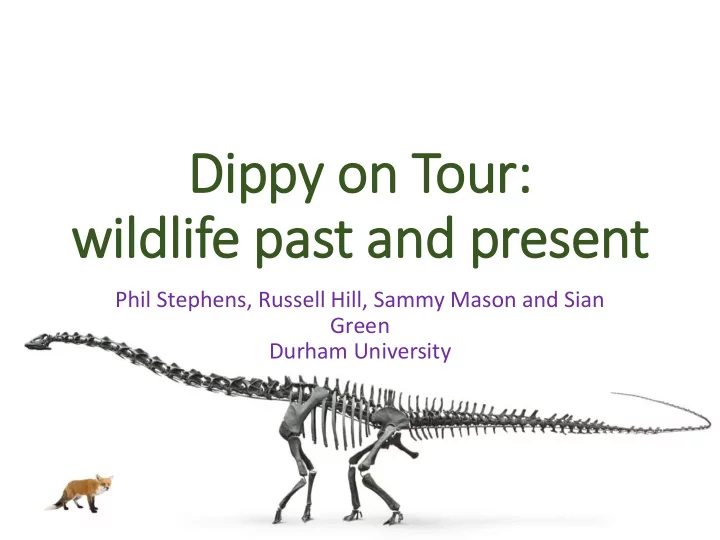

Dippy on Tour: wildlife past and present Phil Stephens, Russell Hill, Sammy Mason and Sian Green Durham University
> Outline > Background > What we do > Where you come in Outline Engaging school pupils and museum visitors in an interactive effort to monitor local mammalian wildlife • Background • Monitoring • Policy and management • Engagement • What we do • MammalWeb • Engaging schools • MammalWeb at the GNM • How it will work
> Outline > Background > What we do > Where you come in Why monitor mammals? • Ecology • monitoring, explaining and predicting responses to environmental change
> Outline > Background > What we do > Where you come in Why monitor mammals? • Ecology • monitoring, explaining and predicting responses to environmental change • Policy and management • cultural value • conservation • control of pest species • invasive species • disease contingency
> Outline > Background > What we do > Where you come in Why monitor mammals? • Ecology • monitoring, explaining and predicting responses to environmental change • Policy and management • cultural value • conservation • control of pest species • invasive species • disease contingency • Engagement and awareness
> Outline > Background > What we do > Where you come in Source: National Wildlife Management Centre
> Outline > Background > What we do > Where you come in MammalWeb • Recognises that mammals are scarce and hard to spot • “Camera traps” overcome that • hard to deploy in sufficient numbers • yield huge numbers of images to classify https://vimeo.com/237771257
> Outline > Background > What we do > Where you come in MammalWeb
AIMS: i) encouraging families to explore nature on their doorstep; ii) encouraging young people to connect with the natural world; iii) build partnerships between regional cultural, scientific and wildlife organisations.
> Outline > Background > What we do > Where you come in MammalWeb & Dippy: plans • Natural Northumbria exhibit
> Outline > Background > What we do > Where you come in MammalWeb & Dippy: plans • Natural Northumbria exhibit • Profiles different habitats • Upland • Lowland • Woodland • Seas & Coasts • Introducing Urban
> Outline > Background > What we do > Where you come in MammalWeb & Dippy: plans • School project
> Outline > Background > What we do > Where you come in MammalWeb & Dippy: plans • School project
> Outline > Background > What we do > Where you come in MammalWeb & Dippy: plans • School project
> Outline > Background > What we do > Where you come in MammalWeb & Dippy: plans • Natural Northumbria exhibit • Museum visitors (during Dippy’s visit) • touch screens by each habitat • classify images from that habitat captured by schools
AIMS: i) encouraging families to explore nature on their doorstep; ii) encouraging young people to connect with the natural world; iii) build partnerships between regional cultural, scientific and wildlife organisations.
Questions?
Recommend
More recommend